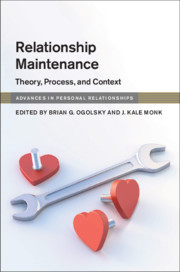Book contents
- Relationship Maintenance
- Advances in Personal Relationships
- Relationship Maintenance
- Copyright page
- Contents
- Tables
- Figures
- Contributors
- Part I Introduction
- 1 Maintaining the Literature on Relationship Maintenance
- Part II Theories of Relationship Maintenance
- Part III Processes of Relationship Maintenance
- Part IV The Social Context of Relationship Maintenance
- Part V Conclusion
- Index
- References
1 - Maintaining the Literature on Relationship Maintenance
from Part I - Introduction
Published online by Cambridge University Press: 02 December 2019
- Relationship Maintenance
- Advances in Personal Relationships
- Relationship Maintenance
- Copyright page
- Contents
- Tables
- Figures
- Contributors
- Part I Introduction
- 1 Maintaining the Literature on Relationship Maintenance
- Part II Theories of Relationship Maintenance
- Part III Processes of Relationship Maintenance
- Part IV The Social Context of Relationship Maintenance
- Part V Conclusion
- Index
- References
Summary
This chapter introduces the book and is organized around the six most basic yet critical questions that cut across all research: Who, What, When, Where, Why, and How. In the first section (“who”), we discuss the types of people who perform relationship maintenance as well as differences among people. The “what” section identifies the central definitional issues that continue to plague the field. The third section (“when”) highlights the conditions under which people perform maintenance as well as the relationship challenges that prompt it. The “where” section identifies the small body of literature on geographic differences in relationship maintenance. The “why” section covers the principal theories that explain engagement in relationship maintenance activities. The final section comments on “how” maintenance activities sustain or enhance relationships. That is, it outlines the correlates, mediators, and moderators that explain the mechanisms by which maintenance operates. We conclude our chapter with a brief overview of the organization of the book.
- Type
- Chapter
- Information
- Relationship MaintenanceTheory, Process, and Context, pp. 3 - 12Publisher: Cambridge University PressPrint publication year: 2019



